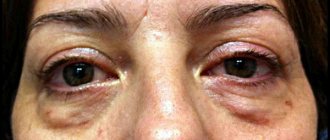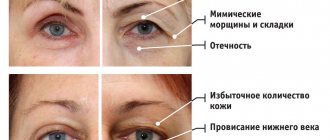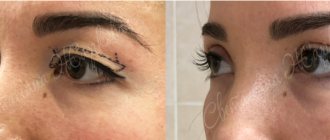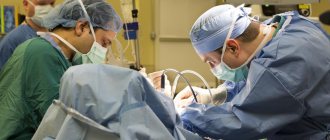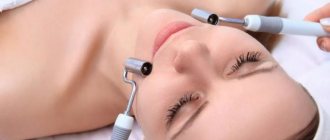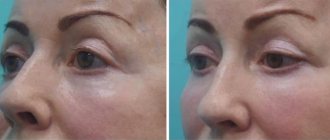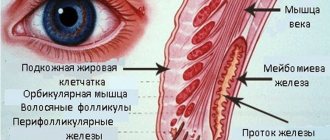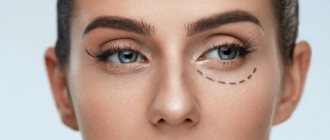Transconjunctival blepharoplasty (sutureless) is an aesthetic surgical intervention on the eyelids. It is designed to relieve the patient of pronounced accumulations of fatty tissue under the eyes.
The main advantage of this plastic surgery is that the incision is made along the membrane of the eye behind the lower eyelid. Thus, after healing, no traces of intervention are visible. In addition, the conjunctiva has more pronounced regenerative abilities than the skin. Therefore, the rehabilitation period itself is significantly shorter than with the traditional percutaneous version of the operation.
Difference from standard eyelid blepharoplasty
In classical surgery, the incision is made on the outer surfaces of the upper and lower eyelids. This is done using a surgical scalpel. This technique is considered risky for the eyes and the skin around them. Therefore, many doctors advise against performing it, recommending the transconjunctival method.
Also, with the classical method, only general anesthesia is performed, which can cause many complications for the patient’s health. With the transconjunctival method, local anesthesia can be used.
With the classical method, the rehabilitation period is significantly increased, since the skin surfaces, blood vessels and nerves have been damaged.
That is why transconjunctival blepharoplasty is considered the safest and most justified method for facial rejuvenation. The surgeon gains access to the desired area through the mucous membrane and conjunctiva of the eye. There is no incision; instead, a puncture is made. Therefore, there are no stitches left, and the doctor does not damage the vessels and nerves.
Kinds
There are several types of operations, they depend on the execution and purpose:
- lower eyelid surgery;
- upper eyelid surgery;
- Circular operations are performed simultaneously on both the upper and lower eyelids.
Transconjunctival blepharoplasty on the lower eyelids is performed to eliminate swelling and hernias, which gives the patient a tired appearance.
This type of intervention has purely cosmetic purposes.
Surgery on the upper eyelids is performed to remove excess area; this may be necessary to improve visual acuity; the procedure is prescribed by an ophthalmologist.
Other types of transconjunctival blepharoplasty:
- correction of Asian eye shape (epicanthus);
- correction of drooping corners of the eyes;
- treatment of a bulging eyeball.
Indications for surgery
First of all, surgical intervention is performed for patients who want to eliminate a cosmetic defect in the form of bags under the eyes, severe wrinkles, and sagging skin. The procedure is also indicated for the following conditions and diseases:
- damage to the protective septum of the eye, hernia formation;
- excessive drooping of the skin of the eyelids, which interferes with normal life activities;
- stretching of the skin above and below the eye, as well as in the corner above the eyebrow;
- excessive accumulation of subcutaneous fat, which forms large bags under the eyes.
If bags under the eyes are associated with severe sagging skin, the procedure will be ineffective and will only slightly improve the patient’s condition. With the transconjunctival method, it is possible to completely eliminate the bags only in the presence of excess adipose tissue.
Advantages
The transconjunctival blepharoplasty method has a number of undeniable advantages, which makes it attractive to patients:
- low morbidity during the operation;
- absence of stitches in the area of the eyelid where blepharoplasty was performed;
- a short rehabilitation period, it lasts only 7–10 days, after this period the swelling of the eyelids completely disappears;
- low risk of complications;
- the result of surgery looks natural.
Contraindications
The procedure is not recommended for the following conditions and diseases:
- minor age;
- infectious and viral diseases in the acute stage;
- presence of menstrual bleeding in women;
- malignant neoplasms in any tissues and organs;
- hormonal imbalance, pathologies of the endocrine glands;
- any disturbances in the circulatory system;
- increased bleeding time, decreased blood clotting;
- increased intraocular pressure or glaucoma;
- high blood pressure;
- autoimmune disease (rheumatoid arthritis, systemic lupus erythematosus, autoimmune reactions in thyroid diseases);
- dry eye syndrome – insufficient hydration in the absence or reduced secretion of tear fluid;
- congenital or acquired immunodeficiency.
Some of these contraindications are temporary. When their effect is completed, the doctor can give a referral for surgery.
If the patient has a serious illness of the body, blepharoplasty is completely prohibited.
Preparation for transconjunctival blepharoplasty
To carry out the procedure, the patient should undergo all studies and tests so that no side effects or complications arise during the operation or during the rehabilitation period.
Before the procedure, the patient should undergo tests:
- general clinical analysis of blood and urine, blood biochemistry, coagulogram;
- testing for hepatitis and HIV;
- fluorography;
- electrocardiogram.
If there are no contraindications based on these data, the patient is referred to specialist doctors. He must see an ophthalmologist, otolaryngologist, dentist, and neurologist.
Before the procedure itself, the patient should prepare:
- 2 weeks before surgery, it is prohibited to use medications that the doctor has not been warned about;
- any medications that may thin the blood are discontinued;
- you should not visit places with active sun;
- It is prohibited to consume alcohol and nicotine 3 days before the procedure.
You should not wear makeup on the day of surgery. The patient should take a warm shower and thoroughly wash his hair and face. It is also recommended to take sick leave at work, since visiting her is not recommended during the rehabilitation period.
Carrying out the operation
The procedure is carried out quickly, the maximum time is 1 hour. But if there are complications, the time may increase. Before anesthesia is administered, markings are made on the face using a special marker. The doctor will use it to determine which areas need to be tightened and where the amount of fatty tissue needs to be reduced.
Next, the procedure is carried out in several stages:
- Use of anesthetic in required areas of the face.
- The use of epinephrine, which is an analogue of adrenaline. It reduces the risk of bleeding.
- The surgeon makes a miniature puncture in the conjunctival area, which is located behind the eyelash growth area. No further incisions are made.
- Using a special device, the doctor removes excess fat tissue.
- The hole is stitched with suture material, which subsequently dissolves on its own. The surgeon will not need to remove additional suture material. In some cases, the surgeon may refuse to use suture material, then the hole will heal on its own.
- The use of antibacterial, anti-inflammatory agents.
After completion of the procedure, the patient must remain within the walls of the medical institution for several hours. If no complications or side effects appear, he is sent home the same day. This is due to the fact that a small amount of tissue was damaged. The doctor does not need to perform additional manipulations.
The patient is advised to ask for help from close relatives or friends who will pick him up from the medical facility. This is due to the fact that after surgery, visual acuity may decrease for a short period of time. This will also avoid stress on human health immediately after the procedure.
Brief description of the procedure and its features
Today, transconjunctival blepharoplasty of the lower and upper eyelids is performed. By the way, the procedure is performed under local anesthesia, and the patient is conscious the entire time. The operation lasts on average 1-1.5 hours.
As for the features, the incision of the mucous membrane can be performed either using a scalpel or a laser beam (a more modern, faster and safer technique). A special endoscope is inserted through the incision into the subcutaneous space, with the help of which the doctor removes excess fluid and fatty deposits. In the case of upper eyelid blepharoplasty, the surgeon carefully tightens the skin in the superciliary area and sometimes inserts small implants.
It is worth saying that the operation is usually recommended for young patients with elastic skin. If the tissues in the paraorbial region are greatly stretched, then in such cases it is necessary to remove them, which means that only sutureless methods cannot be used.
The patient is discharged from the hospital after 5-7 hours. Naturally, after this you need to come for regular checkups, but basically you can begin to return to your normal life.
Rehabilitation period
To reduce the possibility of side effects and complications after surgery, it is important for the patient to undergo a proper rehabilitation period. The doctor warns the person in advance about its rules:
- the use of antibacterial, anti-inflammatory drops, which prevent the spread of infection to the area of damage, and also relieve redness and swelling of tissues;
- using moisturizing eye drops to prevent increased dryness of the mucous membrane and damage to the corneal layer;
- prohibition on using cosmetics for 1 week after the procedure;
- prohibition on visiting a sauna, bathhouse, sunbathing in the open sun, swimming in hot water for 2-3 weeks after surgery, this will prevent the possibility of bleeding;
- Wearing sunglasses outdoors to prevent eye irritation from bright sunlight;
- long sleep, no increased eye strain in the form of using a computer, telephone and other electronic devices;
- You can go to work 1 week after the operation, but you must obtain permission from the attending physician;
- significantly reduce physical activity, do not engage in active sports until the doctor’s permission;
- You cannot wear contact lenses for 1 month after surgery.
After 1 week, as well as 30 days after the operation, it is recommended to visit the surgeon for a follow-up examination. If there are no side effects, the doctor will gradually lift the ban on any actions.
Possible complications
During the procedure, as well as during the rehabilitation period, the following complications may occur in the patient’s body:
- bleeding from the area of tissue damage;
- corneal bruises, if they are minor, the doctor does not prescribe any medical manipulations, they resolve on their own; in case of extensive bruises, injections of drugs into the eyeball can be used;
- internal hemorrhage near the eyeball, resulting in the formation of a hematoma that does not resolve for a long time;
- damage to the tissues of the eyeball during surgery, which are the most dangerous for the condition of the patient’s visual organs;
- severe bleeding that the doctor cannot stop for a long time;
- formation of age spots under the eyes;
- infection with a bacterial infection with the possibility of suppuration, the formation of cysts and abscesses, this is dangerous for the patient, since the bacterial infection can enter the blood through damaged vessels;
- the appearance of chronic dry eyes with damage to the corneal layer, in this case the patient is prescribed moisturizing drops or injections into the eyeball with special preparations for life;
- severe swelling that does not go away for a long time after surgery;
- increased tearfulness, this condition subsequently disappears with tissue healing;
- deformation of the eyelid, due to which it becomes inverted, which causes dry eyes, inflammation and redness of the surface layer;
- excessive tissue scarring;
- photophobia, accompanied by increased lacrimation, redness of the eyes and spasm of the eyelids;
- decreased visual acuity, which most often recovers within 1 month after surgery;
- increased intraocular pressure, which can subsequently form glaucoma.
If the patient chooses a highly qualified surgeon, the risk of complications is significantly reduced. But with health problems, especially in old age, certain risks remain. Therefore, doctors recommend a comprehensive examination of the body before the procedure.
Stories from our patients:
Yulia29.01.2021
Many thanks to the wonderful doctor Valery Grigorievich! I had rejuvenation surgery in 2021. Several years have passed, nothing has changed, only everything has gotten better! Especially the neck, you have no equal in this! There is no need to wait for quick rehabilitation and quick results! Everything will be great, but in a year... At least in my case, everything is individual! But, you are the best! I hope to meet you again, health permitting!
Read moreHide
Tatyana K.07/24/2020
Thank you very much, Valery Grigorievich! I am so glad that I chose you for my surgery. I look 20-25 years younger now (I'm 59). I myself did not expect to see such a young face. I am very happy. My husband is surprised that this could happen. He also really likes the result. Many thanks to everyone who helped you - Tatyana Alexandrovna and Anna Sergeevna. Many thanks to the anesthesiologists and nurses. The operation and recovery from anesthesia were very easy for me. Thanks to Alexandra, she has always been and remains in touch, thanks to cosmetologist Natalya Nikolaevna For women visiting the site and reading this review, I can add that the intervention was extensive: forehead endoscopy, SMAS, platysmoplasty and lower blepharoplasty. All this was done in 1 time - clearly, quickly, professionally. Therefore, there were no blue-black bruises at all. On the 3rd day, pale yellow bruises appeared under the eyes (already passing). There was no severe swelling. A week later, I calmly (wearing dark glasses) went out into the street. By now, 2 weeks have passed since the operation. The scarring process is completely painless, it is not visible from the outside. There remains a slight numbness of the chin, neck and forehead. But gradually sensitivity returns. You can feel it too. In general, the rehabilitation process is easy to bear, especially with such an emotional high from SUCH a stunning result.
Read moreHide
Tatyana K.07/17/2020
Thank you very much, Valery Grigorievich!
I am so glad that I chose you for my surgery. I look 20-25 years younger now (at 59). I myself did not expect to see such a young face. I am very happy. My husband is surprised that this could happen. He also really likes the result. Many thanks to everyone who helped you - Tatyana Alexandrovna and Anna Sergeevna. Many thanks to the anesthesiologists and nurses. The operation and recovery from anesthesia were very easy for me. Thanks to Alexandra, she has always been and remains in touch. For those visiting the site and reading this review, I can add that the intervention was extensive: forehead endoscopy, SMAS, platysmaplasty and lower blepharoplasty. All this was done in 1 time - clearly, quickly, professionally. Therefore, there were no blue-black bruises at all. On the 3rd day, pale yellow bruises appeared under the eyes (already passing). There was no severe swelling. A week later, I calmly (wearing dark glasses) went out into the street. By now, 2 weeks have passed since the operation. The scarring process is completely painless, it is not visible from the outside. There remains a slight numbness of the chin, neck and forehead. But gradually sensitivity returns. You can feel it too. In general, the rehabilitation process is easy to bear, especially with such an emotional high from SUCH a stunning result. I don’t even want to use cosmetics)) Read moreHide
